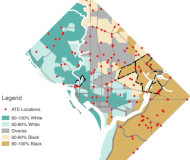7/20/2018
DC Report Finds Racial Bias In Speed Camera UseSpeed cameras in Washington, DC are placed in minority neighborhoods to generate higher ticket volumes.

Speed cameras in the nation's capital are overwhelmingly placed in minority neighborhoods according to a study released earlier this month by the DC Policy Center, a non-partisan think tank. Analyst William Farrell used Census Bureau data to determine the racial makeup of the sections of Washington, DC where cameras have been installed. He then compared this information with the geographic distribution of speed camera tickets and the amount of fine revenue collected in 2016.
"My analysis of moving violations, citations and crash data suggests that the racial geography of DC does play into in the enforcement of traffic violations," Farrell wrote. "Census tracts with higher proportions of black residents are associated with a higher incidence of traffic fines, despite not experiencing a greater number of crashes."
The District collected $115 million in profit from traffic tickets in 2016, 97 percent of which were issued by red light cameras and speed cameras. Neighborhoods where 80 percent or more of residents are black on average paid $322 per capita in automated traffic tickets compared to just $20 per capita in 80 percent white neighborhoods. Residents in black neighborhoods were 17 times more likely to receive a photo ticket.
Cameras placed in black neighborhoods produced a large amount of revenue, but these areas are not inherently more dangerous. The per capita rate of crashes in black neighborhoods is essentially the same as the rate in white neighborhoods.
While the District has used its speed camera contractor to produce numbers claiming the system has reduced accidents, an independent investigation by The Washington Post found a 107 percent increase in accidents at the intersections where red light cameras were used. An analysis of accident records conducted last year by Howard University researchers found that the District and its for-profit vendor placed cameras on safe, high-volume roads, not locations with a history of fatal accidents (view study).
"As with many technologies, even 'neutral' automated traffic cameras can be used in ways that unintentionally further racial disparities," Farrell concluded. "Given the District's high degree of residential racial segregation, decisions about where and how to use 'neutral' technology like speed cameras can still have a disparate impact in terms of outcomes."
A copy of the report is found on the DC Policy Center website.


